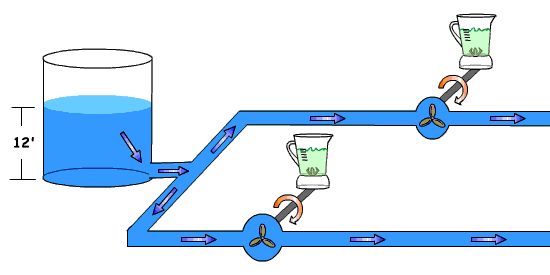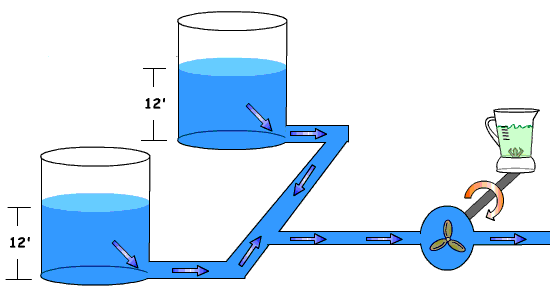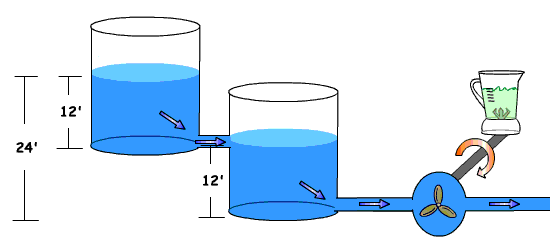(→2 Series Tanks 1 Blender: 2nd tank is closed) |
|||
| Line 140: | Line 140: | ||
*The blender is 4 times the speed as our test case. | *The blender is 4 times the speed as our test case. | ||
*The total flow is twice the speed as our test case. | *The total flow is twice the speed as our test case. | ||
PS The second tank has a lid that keeps it closed. | |||
==Background Essentials== | ==Background Essentials== | ||
Revision as of 22:46, 18 March 2019
Some basic definitions, equations and analogies of electricity.
Definitions
| Symbol | Unit | Description | Water Analog | Elec. Units | Base Units | |
|---|---|---|---|---|---|---|
| Voltage | V | volt (V) | Pressure (Potential) difference due to charge difference | Head: Pressure (Potential) difference due to height difference | J/C | kg•m²/(s³•A) |
| Current | I | amp (A) | Flow of charge in charge/time or coulombs/sec | Flow: Flow of water in volume per time such as liters/sec | C/s or W/V | A |
| Resistance | R | ohm (Ω) | Opposition to the flow of charge | Friction: Opposition to the flow of water | V/A | kg•m²/(s³•A²) |
| Power | P | watt (W) | Energy/Time also Power=Current (I) * Voltage (V) | Power: Power=Flow (Q) * Pressure (H) | J/s or A•V | kg•m²/s³ |
| Energy | E | watt-hour (Wh) | The ability to do work | Energy: The ability to do work | 3600 J | kg•m²/s² |
Equations
- P=IV
- Power=Current*Voltage
- look familiar see P=Q*H*e/k
- V=IR
- Volts=Current*Resistance
- I=V/R might be more edifying since current is usually the result of pressure acting on resistance.
- This only applies to ohmic circuits, those circuits which display a linear relationship between current and voltage (i.e. the resistance does not change based upon current or voltage).
| Series | Parallel |
|---|---|
| VT=V1+V2+… | V stays same |
| I stays same | IT=I1+I2+… |
| RT=R1+R2+… | 1/RT=(1/R1)+(1/R2)+… |
Analogies
The following animated analogy illustrates the operation of direct current (DC) circuits.
| Water Tank - Electricity Analogy | |
|---|---|
| Component | Analog |
| Tank | Battery |
| Tank Vertical Difference | Battery Voltage Difference |
| Water Flow | Electrical Current |
| Mechanical Energy Appliance (Blender) | Electrical Energy Appliance |
| Power=Head*Flow | Power=Voltage*Current |
For each example, ask yourself:
- How fast will the battery run out?
- How fast will the virgin margaritas be made?
- And most importantly why?
If you would like to do math to support these analogies, use:
- Feet = volts
- GPM = amps
- Each blender has a resistance of 6 Feet/GPM = 6 ohms
1 Tank 1 Blender
- This is the test case (datum).
1 Tank 2 Series Blenders
Notice that:
- The flow is 1/2 the speed of our test case.
- The two blenders in series are each going 1/4th the speed of our test case.
1 Tank 2 Parallel Blenders
Notice that:
- Each blender is at the same speed as our test case.
- The flow from the tank is twice as fast as our test case.
2 Parallel Tanks 1 Blender
Notice that:
- The blender is the same speed as our test case.
- The flow from each tank is half as fast as our test case.
2 Series Tanks 1 Blender
Notice that:
- The blender is 4 times the speed as our test case.
- The total flow is twice the speed as our test case.
PS The second tank has a lid that keeps it closed.
Background Essentials
See Rural Electrification Systems for more background information (these page should be integrated together).
External links
- Everything you every wanted to know about Lead Acid batteries.
- Car and Deep Cycle Battery FAQ
- Fantastic site on physics in general. Easy to understand, but accurate information on DC Circuits.
- HyperPhysics - DC Circuits
- Some easy to follow basic theory.
- Lesson 3: Electricity - Colegio Franklin Delano Roosevelt
- Some more information on electricity. Not wrot with error like at least one of their other pages.
- How Stuff Works - Electricity
- Understanding current




